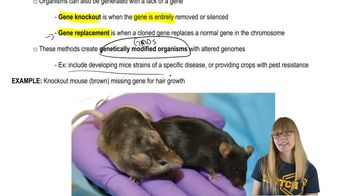Here are the essential concepts you must grasp in order to answer the question correctly.
Gene Cloning
Gene cloning is a molecular biology technique used to create copies of a specific gene. This process involves isolating the gene of interest, such as the human insulin gene, and inserting it into a vector, typically a plasmid. The vector is then introduced into a host organism, allowing it to express the gene and produce the desired protein.
Recommended video:
Transgenic Animals
Transgenic animals are genetically modified organisms that have had a foreign gene inserted into their genome. In the context of producing human insulin in sheep, the sheep would be engineered to carry the human insulin gene, enabling them to synthesize insulin in their milk. This approach leverages the natural lactation process to harvest the therapeutic protein efficiently.
Recommended video:
Transgenic Organisms and Gene Therapy
Protein Harvesting and Purification
Protein harvesting and purification involve extracting and refining proteins from biological sources for therapeutic use. After the transgenic sheep produce milk containing human insulin, the insulin must be separated from the milk and purified to ensure it is safe and effective for human use. This process typically includes techniques such as centrifugation, filtration, and chromatography.
Recommended video:




